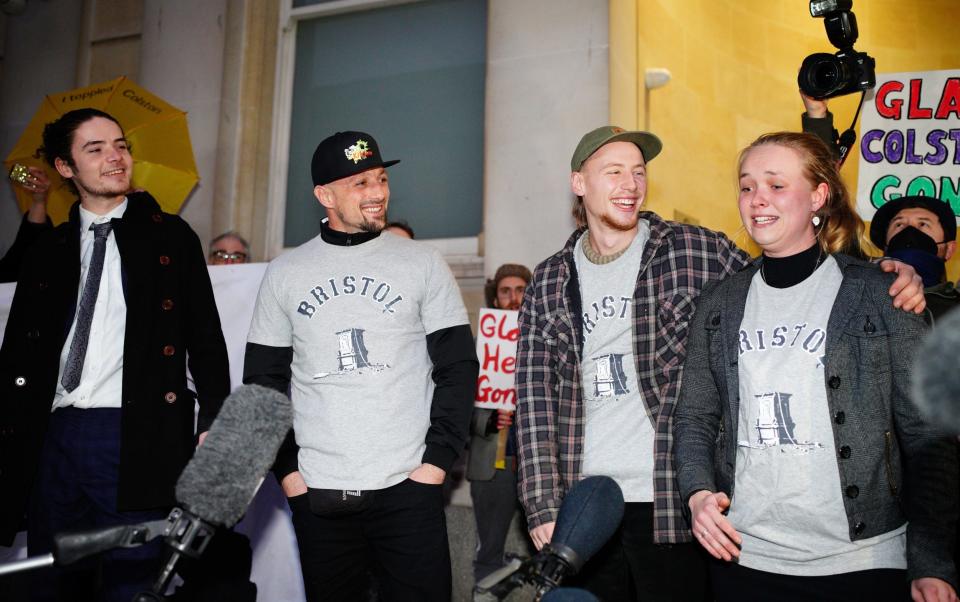Toppling Edward Colston’s statue not protected by human rights, judges rule

- Oops!Something went wrong.Please try again later.
Toppling Edward Colston’s statue was not protected by human rights laws, judges have decided in a landmark ruling.
The Court of Appeal ruled that human rights was not a defence for significant damage or that caused during violent protests such as the felling of Colston’s statue in Bristol.
Instead, the three judges - led by Lord Chief Justice Lord Burnett - ruled protesters might only “theoretically” be able to claim human rights as a defence for criminal damage if it was “minor or trivial”.
Their judgment came after Suella Braverman, when she was Attorney General, asked the Court of Appeal to review the case of four protesters cleared of toppling the bronze memorial to Colston, a 17th-century merchant whose company transported slaves, during a Black Lives Matters demonstration.
The new Home Secretary asked the judges to clarify the law amidst concerns that the “Colston Four” verdict could set a legal precedent that would allow people to argue their human right to protest overrode criminal damage.
The ruling does not overturn their acquittal but it will have far-reaching consequences for defences that protesters use in future to defend violent demonstrations be it blocking roads and oil depots or tearing down statues or memorials.
In a summary of the judgment, the court said: “The European Convention on Human Rights does not provide any protection for violent/non-peaceful conduct in the course of protest. Neither would it be disproportionate to convict someone of causing significant damage to property or damage to private property.”

Lord Burnett said: “Although this case did not involve the destruction of the statue, the damage that was caused was clearly significant. Pulling this heavy bronze statue to the ground required it to be climbed, ropes attached to it and then the use of a good deal of force to bring it crashing to the ground.”
He added: “The circumstances in which the statue was damaged did not involve peaceful protest. The toppling of the statute was violent. Moreover, the damage to the statue was significant.
“On both these bases, we conclude that the prosecution was correct in its submission at the abuse hearing that the conduct in question fell outside the protection of the Convention.”
However, the Court of Appeal judges accepted that Strasbourg case law had established that where damage to property during a protest was “transient or insignificant”, this had not been found to be “outside” protection offered by the Convention.
However, it accepted that Strasbourg judges had argued that “any” damage caused to property during a protest, however minor, was not protected by human rights.
“It is theoretically possible that cases involving minor or trivial damage to property heard in the Magistrates’ Court may raise a question of the proportionality of conviction. In those limited circumstances, a conviction may not be a proportionate response in the context of protest,” said the summary judgement.
However, the judges made clear that damage worth less than £5,000 - the cut-off point for dealing with the case in magistrates rather than crown court - could still be “significant”, potentially denying protesters the protection of human rights.
Human rights group Liberty expressed concern that the judgment set a threshold above which rights were weakened. “By placing weight on the value of an object in deciding if human rights can be taken into account, we feel that the court is shifting the balance too far away from our essential human rights,” said Liberty lawyer Katy Watts.
Raj Chada, a partner at law firm Hodge Jones and Allen, who represented the four, said: “The clear view from an expert valuer, which we were prevented from relying upon during the trial, was that the value of the statue had increased exponentially after the toppling.
“The statue is still on public display as a monument to the evils of the slave trade, not as an obscene glorification of a slave trader. It is a shame that this is the attorney general’s focus rather than the multiple crises facing this country.”

